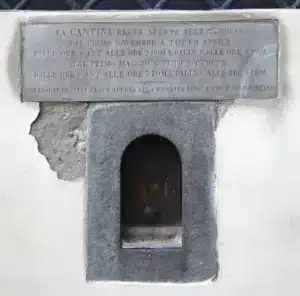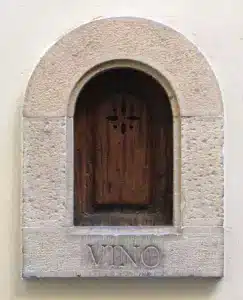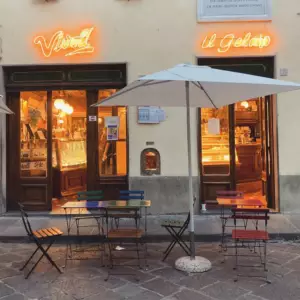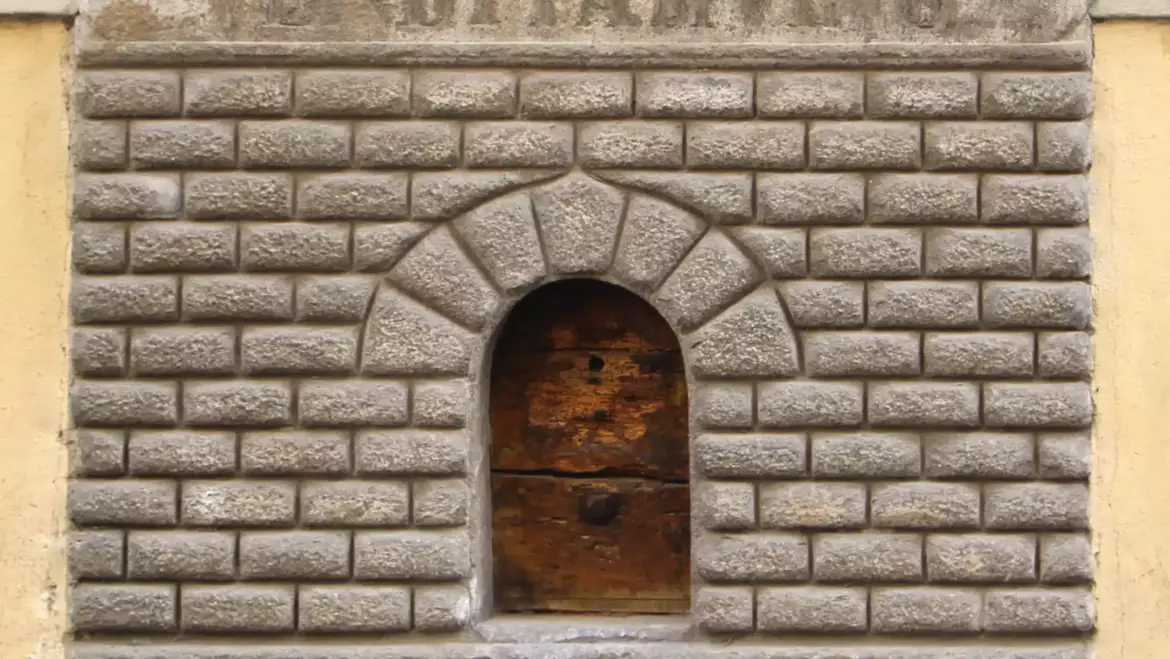There is a moment, during certain walks through Florence, along the hidden routes suggested by Villa Landucci, when you feel the need to slow down. A patch of shade, a detail that slips past the frenzy. And often, right next to an ancient palazzo, just a few centimetres above the pavement, a tiny doorway framed in stone appears: discreet, mysterious, set low like a whispered greeting. These are the wine windows, one of the most fascinating secrets of Renaissance Florence – and today, surprisingly, back in the spotlight.
A leap back in time… with Stanley Tucci It was actor Stanley Tucci who brought them back into vogue, at least in the English-speaking world. In his series Searching for Italy, he walked the streets of Florence with the same wonder of someone discovering a secret passage. That’s exactly how he presented them: as tiny windows into the past, where wine was once sold directly from the producer to passers-by with a system that combined practicality and discretion.
And from there, curiosity took off. Many people began to look at the walls with different eyes, searching for those forgotten openings, often covered by modern plaster or turned into mail slots, yet still alive in the city’s memory.
What exactly are the wine windows? The wine windows – or “wine portals”, as they are sometimes called – are small arched openings, usually with a wooden shutter, carved into the walls of noble palazzi, mainly between the sixteenth and seventeenth centuries. Wealthy families, often wine producers themselves, used these apertures to sell their production directly to townspeople, avoiding the taxes imposed on retailers and keeping a direct (and profitable) relationship with the public.
The wine was served in flasks or jugs, passed through the window, while payment was made the same way: a simple, quick transaction and – at least on the surface – a safe one, even in times of plague.
But not all that glitters is gold. The wine sold through the windows was often already “turned” – we would say slightly vinegary today – and far from the quality we are accustomed to. Even so, it was still considered better than the often undrinkable tavern wine.
A sort of half-fraud, then, played at the expense of ordinary citizens, entirely to the advantage of the noble families, who cleared their cellars of what could no longer be sold elsewhere.
Forgotten, then rediscovered For decades, the wine windows remained there, silent. Some bricked up, others repurposed, many forgotten. But their charm never entirely faded. Today, thanks to the work of the Buchette del Vino Association, more than 180 openings have been catalogued in the historic centre of Florence alone. Some are in excellent condition; others require a more attentive eye – but each tells a story.
The wine windows today: original, restored, reinvented If the windows are back in fashion today, it is not just because of their history but also thanks to the way some businesses have reinvented them. During the pandemic, for example, several wine bars and cafés actually made use of them again, serving glasses of wine, gelato, or small snacks straight through those historic openings. A creative response to new requirements and a poetic way to bring the past back to life.
 📍 Via delle Belle Donne, 2 One of the best-preserved wine windows, complete with stone frame and wooden shutter still visible. Here the charm of the Renaissance lies in the patina that time has darkened on the stone.
📍 Via delle Belle Donne, 2 One of the best-preserved wine windows, complete with stone frame and wooden shutter still visible. Here the charm of the Renaissance lies in the patina that time has darkened on the stone.
 📍 Palazzo Antinori – Via Tornabuoni One of Florence’s historic wine families could only boast an elegant window perfectly set into the façade of the palazzo. It is no longer in use, but remains a symbol of how the nobility kept a direct relationship with the city.
📍 Palazzo Antinori – Via Tornabuoni One of Florence’s historic wine families could only boast an elegant window perfectly set into the façade of the palazzo. It is no longer in use, but remains a symbol of how the nobility kept a direct relationship with the city.
 📍 Vivoli – Via Isola delle Stinche The famous gelateria has re‑activated its own window: from here you can order cones and cups, just as wine was once ordered. A beautiful example of how historical heritage can become an everyday gesture.
📍 Vivoli – Via Isola delle Stinche The famous gelateria has re‑activated its own window: from here you can order cones and cups, just as wine was once ordered. A beautiful example of how historical heritage can become an everyday gesture.
A heritage to protect The wine windows are much more than an architectural curiosity. They are tangible evidence of a Florence that knows how to reinvent itself, mixing elegance and ingenuity, tradition and pragmatism. Today, with their growing – even tourist – appeal, it is important to protect, enhance and tell their story.
Many private palazzi still preserve them, though they are often covered or inaccessible. Some are decorated with small plaques or pietra serena frames; others are simply carved into the memory of residents. Walking around Florence searching for them is a bit like following an invisible treasure hunt.
Tip for the urban explorer If you want to discover the wine windows calmly and with a sense of wonder, we suggest starting in the morning, when the streets are still quiet. Neighbourhoods like the Oltrarno, Borgo Pinti and San Niccolò hide some of the most fascinating ones. And perhaps, after your discovery, treat yourself to a stop in one of the nearby historic osterias for a simple, sincere lunch – in the spirit of these tiny windows through time.
A Florence to discover… step by step In a city where every stone tells a story, the wine windows represent a little‑known yet extraordinarily evocative chapter. Small, humble and yet profoundly elegant, they remind us that the beauty of Florence is not only in its great monuments but also in the details – those you see only when you walk slowly, with curious eyes and an open heart.
A final reflection (and a personal tip) We have discovered, with some amazement, that in the Renaissance the wine sold through the windows was often linked to very poor, flawed products, perhaps even undrinkable. A little Florentine trick at the expense of passers‑by, who were led to believe they were buying good wine, while the real motive was to clear out the cellars.
So one wonders: have these behaviours really changed in five hundred years?
When in doubt, I prefer to rely on a good wine shop, where I can choose a bottle knowingly and enjoy it without surprises. The wine windows are beautiful to look at, but when it comes to wine… better to go where you find the wine you like!





